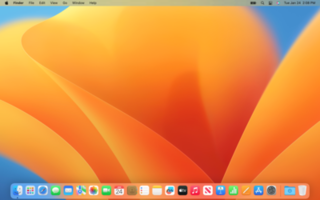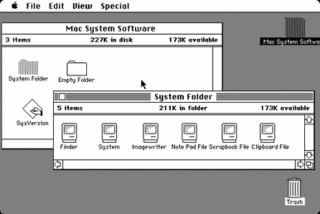
macOS is a Unix operating system developed and marketed by Apple Inc. since 2001. It is the primary operating system for Apple's Mac computers. Within the market of desktop and laptop computers, it is the second most widely used desktop OS, after Microsoft Windows and ahead of Linux.

Mac OS X Server is a discontinued series of Unix-like server operating systems developed by Apple Inc. based on macOS. It provided server functionality and system administration tools, and tools to manage both macOS-based computers and iOS-based devices, network services such as a mail transfer agent, AFP and SMB servers, an LDAP server, and a domain name server, as well as server applications including a Web server, database, and calendar server.

The TeachText application is a simple text editor made by Apple Computer and included with System 7.1 and earlier. It was created by Apple programmer Bryan Stearns with later versions created by Stearns and Francis Stanbach. TeachText was one of the only applications included with System 7, leading to its frequent role as the application to open "ReadMe" files. It was named "TeachText" as a nod to this role in tutorials and other introductory materials.
Hierarchical File System (HFS) is a proprietary file system developed by Apple Inc. for use in computer systems running Mac OS. Originally designed for use on floppy and hard disks, it can also be found on read-only media such as CD-ROMs. HFS is also referred to as Mac OS Standard, while its successor, HFS Plus, is also called Mac OS Extended.

Lisa is a desktop computer developed by Apple, released on January 19, 1983. It is one of the first personal computers to present a graphical user interface (GUI) in a machine aimed at individual business users. Its development began in 1978. It underwent many changes before shipping at US$9,995 with a five-megabyte hard drive. It was affected by its high price, insufficient software, unreliable Apple FileWare floppy disks, and the imminent release of the cheaper and faster Macintosh. Only 10,000 were sold in two years.

The Macintosh Plus computer is the third model in the Macintosh line, introduced on January 16, 1986, two years after the original Macintosh and a little more than a year after the Macintosh 512K, with a price tag of US$2,599. As an evolutionary improvement over the 512K, it shipped with 1 MB of RAM standard, expandable to 4 MB, and an external SCSI peripheral bus, among smaller improvements. Originally, the computer's case was the same beige color as the original Macintosh, Pantone 453; however, in 1987, the case color was changed to the long-lived, warm gray "Platinum" color. It is the earliest Macintosh model able to run System Software 5, System 6, and System 7, up to System 7.5.5, but not System 7.5.2.
The history of macOS, Apple's current Mac operating system formerly named Mac OS X until 2011 and then OS X until 2016, began with the company's project to replace its "classic" Mac OS. That system, up to and including its final release Mac OS 9, was a direct descendant of the operating system Apple had used in its Mac computers since their introduction in 1984. However, the current macOS is a Unix operating system built on technology that had been developed at NeXT from the 1980s until Apple purchased the company in early 1997.

The Power Macintosh G3 is a series of personal computers designed, manufactured, and sold by Apple Computer from November 1997 to August 1999. It represented Apple's first step towards eliminating redundancy and complexity in the product line by replacing eight Power Macintosh models with three: Desktop and Mini Tower models for professional and home use, and an All-In-One model for education. The introduction of the Desktop and Mini Tower models coincided with Apple starting to sell build-to-order Macs directly from its web site in an online store, which was unusual for the time as Dell was the only major computer manufacturer doing this. Apple's move to build-to-order sales of the Power Macintosh G3 also coincided with the acquisition of Power Computing Corporation, which had been providing telephone sales of Macintosh clones for more than two years.

System 7, codenamed "Big Bang", and later also known as Mac OS 7, is a graphical user interface-based operating system for Macintosh computers and is part of the classic Mac OS series of operating systems. It was introduced on May 13, 1991, by Apple Computer It succeeded System 6, and was the main Macintosh operating system until it was succeeded by Mac OS 8 in 1997. Current for more than six years, System 7 was the longest-lived major version series of the classic Macintosh operating system. Features added with the System 7 release included virtual memory, personal file sharing, QuickTime, QuickDraw 3D, and an improved user interface.
A desk accessory (DA) in computing is a small transient or auxiliary application that can be run concurrently in a desktop environment with any other application on the system. Early examples, such as Sidekick and Macintosh desk accessories, used special programming models to provide a small degree of multitasking on systems that initially did not have any other multitasking ability.

The Macintosh 512Kenhanced (512Ke) was introduced in April 1986 as a cheaper alternative to the top-of-the-line Macintosh Plus, which had debuted three months previously. It is the same as the Macintosh 512K but with the 800K disk drive and 128K of ROM used in the Macintosh Plus. Like its predecessors, it has little room for expansion. Some companies did create memory upgrades that brought the machine up to 2 MB or more.
PlainTalk is the collective name for several speech synthesis (MacinTalk) and speech recognition technologies developed by Apple Inc. In 1990, Apple invested a lot of work and money in speech recognition technology, hiring many researchers in the field. The result was "PlainTalk", released with the AV models in the Macintosh Quadra series from 1993. It was made a standard system component in System 7.1.2, and has since been shipped on all PowerPC and some 68k Macintoshes.

Internet Explorer for Mac was a proprietary web browser developed by Microsoft for the Macintosh platform to browse web pages. Initial versions were developed from the same code base as Internet Explorer for Windows. Later versions diverged, particularly with the release of version 5, which included the cutting-edge, fault-tolerant and highly standards-compliant Tasman layout engine.

The Power Macintosh 6100 is a personal computer designed, manufactured and sold by Apple Computer from March 1994 to March 1996. It is the first computer from Apple to use the new PowerPC processor created by IBM and Motorola. The low-profile ("pizza-box") case was inherited from the Centris/Quadra 610 and 660AV models, and replaced the Macintosh Quadra series that used the Motorola 68040 processor, Apple's previous high-end workstation line.
Apple's Macintosh computer supports a wide variety of fonts. This support was one of the features that initially distinguished it from other systems.

The Apple menu is a drop-down menu that is on the left side of the menu bar in the classic Mac OS, macOS and A/UX operating systems. The Apple menu's role has changed throughout the history of Apple Inc.'s operating systems, but the menu has always featured a version of the Apple logo.
The classic Macintosh startup sequence includes hardware tests which may trigger the startup chime, Happy Mac, Sad Mac, and Chimes of Death. On Macs running macOS Big Sur or later the startup sound is enabled by default, but can be disabled by the user within System Preferences or System Settings (Ventura).

The Macintosh "System 1" is the first version of Apple Macintosh operating system and the beginning of the classic Mac OS series. It was developed for the Motorola 68000 microprocessor. System 1 was released on January 24, 1984, along with the Macintosh 128K, the first in the Macintosh family of personal computers. It received one update, "System 1.1" on December 29, 1984, before being succeeded by System 2.

Mac OS is the series of operating systems developed for the Macintosh family of personal computers by Apple Computer from 1984 to 2001, starting with System 1 and ending with Mac OS 9. The Macintosh operating system is credited with having popularized the graphical user interface concept. It was included with every Macintosh that was sold during the era in which it was developed, and many updates to the system software were done in conjunction with the introduction of new Macintosh systems.












